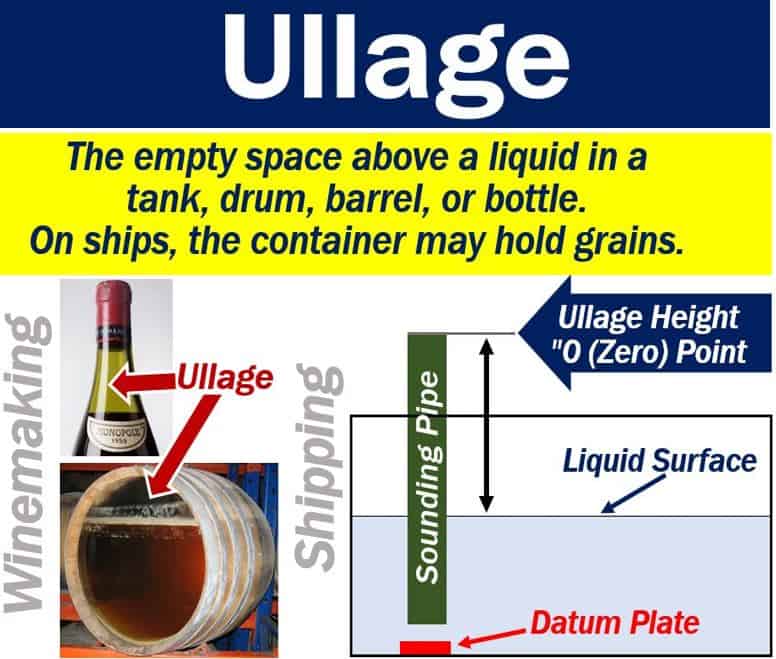What is ullage? Definition and examples
Ullage or headspace is the air space at the top of a barrel, bottle, tank, or drum. The space is usually there so that the liquid can expand as temperatures change. In other words, it is the amount any container falls short of being full. The term may also refer to how much liquid a container has lost due to evaporation or leakage.
In shipping terminology, the term might not refer just to liquids, but also grains.
In customs terminology, ullage refers to how much liquid remains in a container after some of it has evaporated or leaked out.
We sometimes call the liquid that has evaporated or leaked out of the container the ‘angels’ share.’
The Oxford Living Dictionaries have the following two meanings of the term:
“1. The amount by which a container falls short of being full. 2. Loss of liquid, by evaporation or leakage.”

Ullage – etymology
Etymology is the study of where words came from, i.e., their origin, as well as how their meanings have evolved.
With the meaning ‘amount by which a bottle or cask falls short of being full,’ the term first emerged in the English language in the late fifteenth century.
It came from the early fourteenth-century Anglo-French word Ulliage. The Anglo-French word came from the Old French word Ouillage, which came from Oiller.
Oiller meant ‘to fill up (a barrel) to the bung.’ Literally, it meant to fill to ‘the eye.’ Etymonline.com suggests that the word for ‘eye’ was a colloquial term for ‘bung.’
The Old French word came from Latin Oculus, which meant ‘eye.’
Ullage – a winemaking term
In winemaking, the term has several meanings. However, it most commonly refers to the empty air space at the top of a full bottle or barrel of wine.
Ullage may also refer to the process of evaporation.
The space consists mainly of water vapor, carbon dioxide, and alcohol. The mixture is a by-product of fermentation.
If the container is not 100% air-tight, oxygen may also be present in the space. Oak wine barrels or cork-stoppered wine bottles may sometimes allow air to seep in.
While exposing wine to some oxygen is desirable during the aging process, too much is not good. Excessive oxygen concentrations in the ullage can lead to oxidation and other problems which undermine the wine’s quality.
That is why winemakers and people who store wine regularly top up the containers.
Not inspecting and topping up the empty air space can undermine the winemaker’s profit margin. In this context, profit margin refers to the business’ profitability.
The ullage in a bottle can even tell us what level of care the wine has had. It can also give us an idea of its storage conditions.
Auction houses and resellers of wine always inspect ullage levels, especially of older vintages.
Ullage – brewing
In brewing, ullage is the residue that remains in the barrel after somebody has emptied it.
When brewers and retailers are calculating their tax returns, they can factor in ullage. In this context, they refer to it as ‘unavoidable barrel wastage.’
Ullage – shipping
In a marine setting, people use the term to describe the empty space in large tanks. The tanks may store grain or liquids.
The International Maritime Organization says that most pressurized tanks on steel ships cannot be more than 98% full. This is because it is necessary for the pressure-relief valve to be in contact with vapor or gas at all times. Many valves do not work when in contact with liquids.
Measuring ullage is also important for a ship’s stability. Sometimes, the cargo may shift towards one side. This subsequently reduces the ship’s margin of stability, i.e., it becomes lop-sided.
Video – What is wine ullage?
In this video, Kris Chislett explains what ullage is in the world of winemaking and wine drinking. He begins by explaining that older wines usually have lower fill levels than younger ones.

